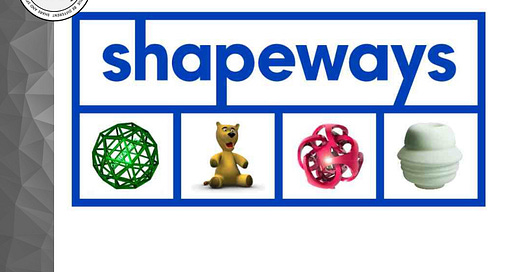08-15-2017: Peter Weijmarshausen - the co-founder of Shapeways, stepped down from his position as CEO
He remained on the company board but eventually left 4 years later. After that, the company started to decline...
On August 15, 2017, Shapeways Co-Founder Peter Weijmarshausen decided to resign as CEO but remained on the Company Board. He was replaced by the then COO, Tom Finn, who served as interim CEO. Eventually, Gregory Kress took the helm, who, as we know, led the company to its ultimate end at the beginning of July this year...
Shapeways began as a spin-off of Royal Philips Electronics in the Netherlands in 2007. It was founded by Peter Weijmarshausen, Robert Schouwenburg, and Marleen Vogelaar. In 2008, Shapeways.com was launched, and in 2010, the company spun out of Philips and moved its headquarters to New York, US.
Thanks to investments made by VC funds, the company built up a very large machine park for that time, consisting of machines printing in SLS, full-color gypsum powder, photopolymer resin, and plastic. But what set the company apart from the beginning was its focus on individual customers, not the industry. Shapeways created a unique platform where designers from all over the world could publish their designs, and customers from around the world could buy them. Shapeways took care of the production...
This was Peter Weijmarshausen’s idea from the beginning. He started his career at a company that published the first free 3D software - Blender. The first 3D printed parts he saw were by Freedom of Creation, printed using SLS technology at Materialise.
As he recalled in an interview with Rachel Park on 3D Printing Industry in 2012:
I can remember being totally amazed at what I was seeing and getting very excited about the possibilities. I called some of my old friends who use Blender and asked if they would be excited about the idea of taking their virtual 3D designs and turning them into real, physical 3D products. At first, people didn’t even believe this was possible, but once they saw the technology, they were completely blown away. The next question I had was, ‘Would you pay money for this?’ And the answer was, ‘Yes!’ So I knew very quickly that there was a business model here.
For 10 years, it worked. Then Weijmarshausen stepped down from the front line, being replaced by Kress. Shapeways changed its logo and business model, focusing on industrial customers and abandoning its consumer legacy. On July 3, 2024, it turned out that this strategy might not have been entirely successful…?
Since 2019, Weijmarshausen has been leading Humane Genomics, which is focused on fighting cancer.





